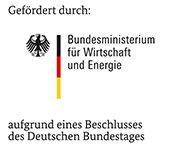18118 N

Hochtemperaturofen in Betrieb
| Laufzeit: | 01.04.2014 - 31.03.2017 |
|---|---|
| Partner: | Bundesanstalt für Materialforschung und ‐prüfung, Berlin |
| Geldgeber: | Bundesministerium für Wirtschaft und Energie (BMWi) über AiF |
| Bearbeiter: | Dr. Raluca Pflumm |
| Arbeitsgruppe: | Hochtemperaturwerkstoffe |
The most severe corrosion problems in biomass-fired systems are caused by chlorine-rich species released during the combustion process. Erosion occurs due to the high content of solid particles in the flue gas characteristic to the fluidised bed technology often used in energy production with biomass as fuel. Such particles are solid reaction products from biomass combustion (i.e. fly ash) as well as gaseous components (i.e. KCl) which condensate, for example on superheaters. Their influence on the corrosion mechanisms is controlled by their hardness and concentration in the gas flow as well as by the force of the overall turbulence specific to each firing technology. Presently studies on the combined mechanisms of corrosion and erosion are rather few.
Biomass fuel can have various characteristics influenced by its type, the region where and the season when it is produced. Most important criteria for the corrosion behaviour are the potassium and chlorine content. The potassium content of the energy plant Miscanthus for example can vary between 0.7 and 7.2%, its chlorine content between 0.2 and 2.2%. Such variations in potassium and chlorine content demand the use of materials with a tailored composition to guarantee a good resistance against corrosion and erosion. Unfortunately, the use of carbides to counteract erosion damage of these materials is not an acceptable alternative due to their poor resistance against high temperature corrosion in Cl-rich environments.
The best solution currently available is the use of Ni-based material systems with high amounts of Cr and Mo, such as Inconel 625. However, the success of such materials has been based on empirical results and not on a profound knowledge of the beneficial influence of different elements such as refractory metals or silicon on their performance. Our aim is to reduce the gap between practical experience and material knowledge by studying the positive effects of the above mentioned elements.
Therefore we present results related first to the corrosion mechanism of different model alloys in a gaseous chlorine-rich atmosphere and second to the combined corrosion-erosion mechanism in ashes retrieved from a real biomass combustion process. The composition of the investigated model alloys is based on a Fe, Ni or a combined FeNi matrix with additions of Nb, Mo, W, and Si. The reference material chosen for this study is In 625/Alloy 625. Particular attention is given to the influence of each element on the corrosion-erosion mechanisms. The development of a metal matrix rich in refractory metals and silicon, able to form hard silicides, is an innovative approach in reducing the combined corrosion-erosion damage at temperatures between 450 and 550°C in alkali- and chlorine-rich oxidizing environments related to biomass firing processes.
zurück
Das IGF-Vorhaben Nr. 18118 N der Forschungsvereinigung DECHEMA e.V., Theodor-Heuss-Allee 25, 60486 Frankfurt am Main wurde über die AiF im Rahmen des Programms zur Förderung der industriellen Gemeinschaftsforschung (IGF) vom Bundesministerium für Wirtschaft und Energie aufgrund eines Beschlusses des Deutschen Bundestages gefördert.
PD Dr. Mathias Galetz
Tel.: 069 / 7564-397
E-Mail: mathias.galetz
Abschlussbericht (pdf, 4,2 MB)